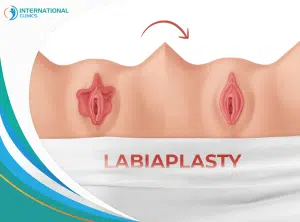Are you curious about labiaplasty surgery side effects? Wondering what this procedure entails and why people choose to undergo it? Labiaplasty is a surgical intervention that can alter the size or shape of the labia minora.
Whether for aesthetic reasons or to relieve discomfort caused by enlarged labia, many women opt for plastic surgery in Turkey. However, it’s essential to make an informed decision based on personal choice and consultation with a qualified surgeon.
Labiaplasty addresses concerns such as labial hypertrophy, which can cause physical discomfort during activities like exercise or sexual intercourse.
Some individuals may experience self-consciousness or dissatisfaction with the appearance of their genitalia. By understanding the potential benefits, risks, and expected outcomes of labiaplasty, you can better evaluate whether it is the right choice for you.
So, if you’re seeking relief from discomfort or considering enhancing your confidence through labiaplasty surgery, let’s delve into the details together.
Labiaplasty Techniques: Exploring Different Approaches for Optimal Results
Labiaplasty surgery is a popular procedure for women seeking vaginal rejuvenation and aesthetic improvements. To achieve optimal results, plastic surgeons utilize various techniques tailored to individual anatomy and desired outcomes.
The Trim Technique
The trim technique involves removing excess tissue along the edge of the labia minora, commonly referred to as the inner lips.
This approach is suitable for patients with elongated or uneven labia minora that extend beyond the labia majora, causing discomfort or self-consciousness. By carefully excising excess skin folds, plastic surgeons can create a more symmetrical appearance and alleviate any functional issues.
Benefits of the Trim Technique:
- Corrects asymmetry by removing excess tissue from one side if necessary.
- Enhances aesthetic appeal by reducing elongated or protruding labia minora.
- Improves comfort during physical activities such as exercise or intercourse.
- Minimizes irritation caused by friction between clothing and enlarged labia.
The Wedge Technique
In contrast to the trim technique, the wedge technique focuses on removing a V-shaped piece of tissue from the middle portion of the labia minora.
This method is often chosen when patients desire a more natural-looking result while preserving most of their original labial edges. Plastic surgeons carefully tailor each incision to maintain symmetry and ensure minimal scarring.
Benefits of the Wedge Technique:
- Preserves natural contours and edges of the labia minora.
- Offers a more conservative approach compared to extensive trimming.
- Reduces chances of visible scarring due to precise incision placement.
- Provides long-lasting results with minimal risk of revision surgery.
Choosing Between Techniques: Determining which technique is best suited for an individual depends on several factors, including the patient’s anatomy and desired outcome.
During the consultation process, plastic surgeons will assess the patient’s labial structure, discuss their concerns, and recommend the most appropriate technique accordingly.
It is important to note that while labiaplasty techniques aim to enhance both aesthetics and function, every surgical procedure carries potential risks and side effects. Patients should thoroughly discuss these aspects with their plastic surgeon before making a final decision.
Get your free medical consultation Now!
Potential Risks of Labiaplasty: Understanding and Managing Complications
It’s important to be aware of the potential risks and complications that can arise. While this procedure is generally safe, like any surgical intervention, there are certain factors that could lead to complications.
Infection, Bleeding, and Scarring
One of the primary risks of labiaplasty surgery is the possibility of infection, bleeding, or scarring. These are common side effects that can occur after any surgical procedure. However, by following proper pre-operative evaluation procedures and employing skilled surgical techniques, these risks can be minimized.
To reduce the risk of infection post-surgery, your surgeon will likely prescribe antibiotics as a precautionary measure.
It’s crucial to follow their instructions diligently to ensure a smooth recovery. Taking care to keep the surgical site clean and avoiding activities that may strain or irritate the area can help prevent infections.
While bleeding is expected immediately after surgery due to incisions made during the procedure, excessive bleeding should be reported promptly to your surgeon. They will provide guidance on managing it effectively.
Scarring is another potential side effect of labiaplasty surgery. However, with advancements in surgical techniques and proper wound care during recovery, scars can often become less noticeable over time. Your surgeon may recommend specific creams or ointments that can aid in reducing scar visibility.
Nerve Damage or Altered Sensation
Another risk associated with labiaplasty surgery is nerve damage or altered sensation in the treated area. Although rare, these complications may occur due to the delicate nature of the genital region.
It’s essential for patients to have realistic expectations about post-surgical sensations and communicate openly with their surgeon before undergoing the procedure. By discussing potential risks and concerns, your surgeon can provide you with a clearer understanding of what to expect.
Minimizing Complications through Pre-Operative Evaluation and Post-Operative Care
To minimize the occurrence of complications during labiaplasty surgery, a thorough pre-operative evaluation is crucial.
Your surgeon will assess your overall health and discuss any underlying medical conditions that may increase the risk of complications. This evaluation helps ensure that you are an ideal candidate for the procedure.
Post-operative care plays a vital role in managing potential risks as well. Your surgeon will provide detailed instructions on wound care, hygiene practices, and activity restrictions during the recovery period. Following these guidelines strictly can help prevent complications and promote optimal healing.
Pain and Recovery After Labiaplasty
Managing Pain after Labiaplasty Surgery
Pain is a common concern for patients undergoing labiaplasty surgery. However, rest assured that your surgeon will prescribe appropriate pain medication to help manage any discomfort you may experience during the recovery process. It’s important to follow their instructions carefully and take the prescribed medication as directed.
Dealing with Swelling and Bruising
Swelling and bruising are natural side effects of labiaplasty surgery. While they can be initially alarming, it’s crucial to remember that they are part of the normal healing process. Typically, swelling and bruising subside within a few weeks following the procedure.
To alleviate swelling and promote faster healing, your surgeon may recommend:
- Applying ice packs or cold compresses to the area
- Wearing loose-fitting clothing to minimize friction
- Avoiding activities that could increase swelling, such as prolonged sitting or standing
By following these guidelines provided by your surgeon, you can help reduce swelling and enhance your overall recovery experience.

Resuming Normal Activities
Most patients can resume their regular daily activities within 7 to 10 days after labiaplasty surgery. However, it’s essential to listen to your body and not push yourself too hard too soon. Engaging in strenuous exercise or activities that put excessive strain on the surgical site should be avoided for several weeks post-surgery.
Here is a general timeline of what you can expect during recovery:
- First Week: Focus on rest and gentle movement.
- Take short walks around your home to improve circulation.
- Avoid sitting for extended periods.
- Maintain good hygiene by following your surgeon’s instructions regarding cleansing.
- Second Week: Gradually increase activity level.
- You may start resuming light exercises like stretching or yoga.
- Continue practicing good hygiene habits for optimal healing.
- Third Week and Beyond: Gradually return to normal routine.
- You can gradually reintroduce more intense exercises, but listen to your body and avoid any discomfort.
- Follow up with your surgeon as scheduled for a check-up.
Remember, every patient’s recovery timeline may vary slightly, so it’s crucial to consult with your surgeon regarding specific guidelines tailored to your needs.
Importance of Post-Operative Instructions
Following post-operative instructions is vital for optimal healing after labiaplasty surgery. Your surgeon will provide you with detailed guidelines on wound care and hygiene practices. These instructions typically include:
- Gently clean the surgical area according to the provided guidelines.
- Applying any prescribed ointments or creams to promote healing.
- Avoiding sexual activity until cleared by your surgeon.
- Wearing loose-fitting underwear made from breathable fabrics.
By adhering strictly to these instructions, you can minimize the risk of complications and ensure a smooth recovery process.
Common Side Effects and Complications of Labiaplasty Surgery and Strategies for Prevention
Temporary Swelling, Bruising, and Discomfort
One of the most common side effects experienced after labiaplasty surgery is temporary swelling, bruising, and discomfort in the treated area. This is a natural response of the body to the surgical procedure. While it can be uncomfortable, it typically subsides within a few weeks as the body heals. To alleviate these symptoms, patients can try:
- Applying ice packs wrapped in a cloth to the area for short periods to reduce swelling.
- Taking over-the-counter pain relievers recommended by their surgeon.
Infection Prevention through Proper Hygiene
Infections are potential complications that can arise after any surgical procedure, including labiaplasty surgery. However, they can be prevented by maintaining proper hygiene throughout the recovery process. Patients should follow these post-operative care instructions:
- Keep the surgical site clean by gently washing it with mild soap and water.
- Pat dry with a clean towel or use a hair dryer on low heat.
- Avoid using tampons or engaging in sexual activity until cleared by their surgeon.
- Wear loose-fitting clothing made from breathable fabrics to promote airflow.
Minimizing Scarring through Careful Techniques
Scarring is another concern for individuals considering labiaplasty surgery; however, with careful surgical techniques and diligent wound care, scarring can be minimized. Surgeons employ various methods to achieve this goal:
- Precise incision placement: Skilled surgeons strategically place incisions along natural creases and folds to minimize visible scarring.
- Dissolvable sutures: The use of dissolvable sutures reduces the need for suture removal while promoting optimal healing.
- Scar creams or silicone sheets: After initial healing has occurred, applying scar creams or using silicone sheets as directed may help fade any remaining scars.
Choosing an Experienced Surgeon and Discussing Expectations
To prevent undesirable outcomes from labiaplasty surgery, it is crucial to choose an experienced surgeon and have open discussions about expectations beforehand. Here are some factors to consider when selecting a surgeon:
- Credentials and experience: Research the surgeon’s qualifications, certifications, and years of experience in performing labiaplasty surgeries.
- Before-and-after photos: Reviewing the surgeon’s portfolio of previous patients can give an idea of their aesthetic style and potential outcomes.
- Consultation: Schedule a consultation to discuss your goals, concerns, and expectations with the surgeon. This allows them to assess your suitability for the procedure.
By following these strategies and guidelines, individuals can mitigate common side effects associated with labiaplasty surgery while increasing their chances of achieving satisfactory results.
Remember that each person’s body may react differently to surgical procedures, so it is essential to consult with a qualified medical professional for personalized advice regarding any specific symptoms or concerns related to labiaplasty surgery.
Secure your appointment at International Clinics by booking now!
Cost of Labiaplasty and Addressing Bleeding Concerns
Factors Affecting the Cost of Labiaplasty
The cost of labiaplasty surgery can vary depending on several factors. One crucial aspect is the surgeon’s experience and expertise.
Highly skilled surgeons with a proven track record may charge more for their services. The location of the procedure can play a role in determining the overall cost. In areas with higher living expenses or where demand for cosmetic procedures is greater, prices tend to be higher.
Another factor that contributes to plastic surgery prices in Turkey is facility fees. The use of a well-equipped surgical facility with state-of-the-art technology and amenities may result in higher charges compared to less sophisticated clinics.
It’s important to note that labiaplasty is often considered an elective or cosmetic procedure by insurance companies. As such, it may not be covered by insurance plans unless there are specific medical reasons for undergoing the surgery.
It’s advisable to check with your insurance provider beforehand to understand what costs will be covered and what you’ll need to pay out of pocket.
Normal Bleeding After Surgery
After undergoing labiaplasty, it is normal to experience some bleeding during the initial recovery period. This bleeding is typically mild and should subside within a few days as your body heals from the surgery.
To manage post-operative bleeding effectively, your surgeon will provide you with detailed instructions on how to care for yourself after the procedure. These instructions may include recommendations such as:
- Using sanitary pads instead of tampons
- Avoiding strenuous physical activities that could increase blood flow to the surgical area
- Keeping the incision site clean and dry
- Applying ice packs or cold compresses as directed by your surgeon
By following these guidelines diligently, you can help reduce any potential complications related to bleeding.
When Should You Be Concerned?
While mild bleeding is expected during the initial recovery phase, it is essential to monitor your condition closely. If bleeding persists or becomes excessive, it may indicate a potential issue that requires medical attention.
If you notice any of the following signs, contact your surgeon promptly:
- Continuous heavy bleeding that saturates multiple sanitary pads within a short period.
- Blood clots larger than a quarter in size.
- Severe pain or discomfort accompanied by excessive bleeding.
Your surgeon will assess your situation and provide appropriate guidance on how to manage the bleeding effectively. Remember, everyone’s healing process is unique, so don’t hesitate to seek professional advice if you have concerns.
Strategies for Avoiding Labiaplasty Surgery Side Effects:
Pre-operative Instructions: Reduce Risks
Following the pre-operative instructions provided by your surgeon is crucial in minimizing the risks and side effects associated with labiaplasty surgery. These instructions typically include guidelines regarding medication use, smoking cessation, and fasting before the procedure.
- Medication Use: It is important to disclose all medications you are currently taking to your surgeon. Certain medications, such as blood thinners or herbal supplements, may need to be temporarily discontinued prior to surgery to minimize bleeding risks.
- Smoking Cessation: Smoking can interfere with the healing process and increase the risk of complications. If you are a smoker, it is highly recommended to quit smoking at least a few weeks before undergoing labiaplasty surgery.
- Fasting Guidelines: Your surgeon will provide specific instructions on when to stop eating and drinking before the procedure. Adhering to these fasting guidelines helps reduce the chances of complications during anesthesia administration.
Choose a Skilled Surgeon: Minimize Complications
Selecting an experienced surgeon who specializes in labiaplasty procedures is essential for minimizing potential side effects and achieving satisfactory results.
- Research and Credentials: Take the time to research different surgeons in your area who perform labiaplasty surgeries. Look for board certification, specialized training, and positive patient reviews as indicators of their expertise.
- Before-and-After Photos: Request to see before-and-after photos of previous labiaplasty patients treated by the surgeon you are considering. This will give you an idea of their skill level and what kind of results you can expect.
- Consultation: Schedule a consultation with your chosen surgeon to discuss your expectations and concerns openly. Clear communication ensures that both you and your surgeon have a shared understanding of what can be achieved through the procedure.
Communicate Expectations Clearly:
Openly communicating your expectations with your surgeon is crucial to ensure that the desired results are achieved. During your consultation, discuss in detail what you hope to achieve through the labiaplasty procedure.
- Desired Outcome: Clearly express how you envision your genital appearance after surgery. This will help your surgeon understand your goals and tailor the procedure accordingly.
- Realistic Expectations: It is important to have realistic expectations about the outcome of labiaplasty surgery. Your surgeon can provide guidance on what can be realistically achieved based on your individual anatomy.
Adhere to Post-operative Care Instructions:
Following post-operative care instructions provided by your surgeon is vital for promoting optimal healing and reducing the risk of side effects.
- Wound Care: Proper wound care is essential during the recovery period. Your surgeon will provide specific instructions on how to clean and dress the surgical site, as well as any recommended ointments or creams.
- Activity Restrictions: To avoid complications and promote healing, it is important to adhere to activity restrictions outlined by your surgeon. This may include avoiding strenuous exercise, sexual activity, or wearing tight clothing for a certain period of time.
Pre-operative Preparations
Before undergoing labiaplasty surgery, there are several important pre-operative preparations that you should be aware of. These preparations will help ensure a smooth and successful surgical procedure with minimal side effects. Here’s what you need to know:
Thorough Examination and Medical History Discussion
Prior to your labiaplasty surgery, your surgeon will conduct a thorough physical examination and discuss your medical history with you. This is crucial in order to assess your overall health and determine if you are a suitable candidate for the procedure. It’s important to provide accurate information about any pre-existing medical conditions or previous surgeries you have undergone.
Medication Considerations
Certain medications can increase the risk of bleeding during surgery, so it may be necessary to avoid them in the days leading up to your procedure.
Your surgeon will provide specific guidelines on which medications to avoid and for how long before the surgery. It’s important to follow these instructions carefully to minimize any potential complications.
Transportation Arrangements
Labiaplasty surgery is typically performed under general anesthesia, which means that driving yourself home after the procedure may not be recommended immediately afterward.
It’s essential to arrange for transportation from the hospital or surgical center back to your home in advance. This ensures your safety and allows you to rest comfortably during the initial recovery period.
Fasting Guidelines
To prepare for anesthesia administration during labiaplasty surgery, your surgeon may provide fasting guidelines that need to be followed strictly.
This usually involves avoiding food and drink for a certain period of time before the procedure. Adhering to these guidelines helps reduce the risk of complications related to anesthesia administration.
During labiaplasty surgery, incisions are made in order to remove excess tissue and reshape the labia minora or majora. The specific technique used depends on individual factors such as the desired aesthetic outcome, the experience of the surgeon, and patient preferences.
The goal of the procedure is to improve the appearance of the labia, enhance comfort during activities such as exercise or sexual intercourse, and boost self-confidence. Labiaplasty can involve various techniques, including edge excision, wedge excision, composite reduction, or a combination of these approaches.
The recovery time after labiaplasty surgery varies from person to person. It’s important to follow your surgeon’s post-operative instructions carefully to ensure proper healing. This may include avoiding strenuous activities for a certain period of time and keeping the surgical area clean and dry.
Post-operative Care
After undergoing labiaplasty surgery, it is crucial to take proper care of the surgical site to ensure a smooth healing process. Here are some essential post-operative care tips to follow:
Keep the Surgical Area Clean and Dry
Maintaining cleanliness and dryness in the surgical area is vital for promoting healing and preventing infection. Gently clean the area with mild soap and water, patting it dry afterward. Avoid using harsh chemicals or fragrances that may irritate the sensitive skin.
Opt for Loose-Fitting Clothing
During the recovery period, it’s recommended to wear loose-fitting clothing to minimize irritation or friction on the treated area. Tight clothing can rub against the incision site and cause discomfort or delay healing. Choose breathable fabrics like cotton to allow proper airflow.
Avoid Sexual Activity, Tampon Use, and Strenuous Exercise
To avoid complications and ensure optimal healing, it is important to refrain from sexual activity, tampon use, or engaging in strenuous exercise until you receive clearance from your surgeon. These activities can put strain on the surgical site and potentially disrupt the healing process.
Attend Follow-Up Appointments
Attending all scheduled follow-up appointments with your surgeon is crucial for monitoring your progress and addressing any concerns that may arise during your recovery period. Your surgeon will assess how well you are healing, remove any sutures if necessary, and provide guidance on additional care instructions.
Manage Swelling, Stitches, Bruising, and Bleeding
It is common to experience swelling, bruising, and minor bleeding after labiaplasty surgery. To manage these side effects effectively:
- Apply ice packs wrapped in a cloth to reduce swelling (20 minutes on, 20 minutes off).
- Take prescribed pain medication as directed by your surgeon.
- Avoid activities that may increase blood flow to the area.
- Do not pick at or scratch any scabs that form.
- If you experience excessive bleeding or notice any signs of infection, contact your surgeon immediately.
Look Out for Signs of Infection or Nerve Damage
While rare, infections and nerve damage can occur after labiaplasty surgery. Be vigilant and watch out for the following signs:
- Increased pain, redness, or swelling that worsens over time.
- Pus or discharge from the surgical site.
- Foul odor coming from the incision area.
- Numbness or tingling sensation in the surrounding areas.
If you notice any of these symptoms, it is crucial to notify your surgeon promptly.
Addressing Complications: Revision Surgery for Undesirable Results
If you’ve undergone labiaplasty surgery and are unhappy with the outcome or experiencing complications, revision surgery may be a viable option to address these concerns. While not everyone will require revision surgery, it can help correct unsatisfactory results or alleviate discomfort caused by complications. Here’s what you need to know about revision surgery for labiaplasty:
When is Revision Surgery Necessary?
In some cases, revision surgery becomes necessary due to various reasons. If you’re dissatisfied with the appearance of your labia after the initial healing period has passed, or if you’re experiencing problems such as asymmetry, excessive scarring, or recurrent discomfort, then discussing your concerns with your surgeon is crucial.
Consultation with Your Surgeon
Before considering revision surgery, it’s essential to have an open and honest conversation with your surgeon. They will evaluate your specific situation and determine whether a revision is appropriate for you. During this consultation, your surgeon will discuss potential risks and benefits associated with the procedure.
It’s important to remember that while revision surgery can address certain issues, it may not guarantee perfection. It’s crucial to have realistic expectations regarding the outcome of the revision procedure.
Potential Risks and Benefits
Revision surgery carries its own set of risks and benefits. Understanding these can help you make an informed decision about whether to proceed with the procedure.
Risks
- Infection: As with any surgical procedure, there is a risk of infection following revision surgery.
- Bleeding: Some patients may experience post-operative bleeding.
- Scarring: Additional scarring may occur as a result of revision surgery.
- Numbness or altered sensation: There is a possibility of temporary or permanent changes in sensation around the surgical area.
Benefits
- Improved aesthetic outcome: Revision surgery can help achieve a more satisfactory appearance.
- Enhanced comfort: Correcting complications can alleviate discomfort experienced after the initial procedure.
- Psychological well-being: Addressing concerns and achieving desired results can improve self-confidence and overall satisfaction.
Recovery and Healing
The recovery process for revision surgery is similar to that of the initial labiaplasty procedure. It’s essential to follow your surgeon’s post-operative instructions carefully to ensure proper healing. This may include avoiding physical activities, maintaining good hygiene, and taking prescribed medications.
During the recovery period, it’s normal to experience some discomfort or swelling. However, if you notice any severe pain, excessive bleeding, or signs of infection such as fever or pus discharge, contact your surgeon immediately.
Long-Term Considerations and Follow-up: Assessing the Durability and Satisfaction of Labiaplasty Results
It’s essential to think beyond the immediate results. Understanding the long-term considerations and follow-up is crucial for assessing durability and satisfaction. Let’s dive into some important points to keep in mind after undergoing labiaplasty.
The Long-Term Durability of Labiaplasty Results
Labiaplasty results can vary among individuals over time due to factors like aging and childbirth. It’s important to note that our bodies naturally undergo changes as we age, which can impact the appearance of the labia. If you plan on having children in the future, pregnancy and childbirth may affect the surgical outcome.
While labiaplasty aims to provide long-lasting results, it’s essential to have realistic expectations about how your body may change over time. Remember that perfection is subjective, and embracing natural changes is a part of life.
Regular Follow-Up Appointments with Your Surgeon
To ensure optimal healing progress and address any concerns post-surgery, regular follow-up appointments with your surgeon are crucial. These appointments allow your surgeon to evaluate how well you are healing and provide guidance on proper care during recovery.
During these visits, don’t hesitate to voice any concerns or ask questions about your progress. Your surgeon is there to support you throughout your journey, so open communication is key for ongoing care.
Patient Satisfaction Rates with Labiaplasty
When realistic expectations are met, patient satisfaction rates with labiaplasty are generally high. Many women report increased self-confidence and improved comfort after undergoing this procedure.
It’s important to remember that every individual’s experience will be unique. While most women find great satisfaction with their labiaplasty results, others may have different feelings or outcomes. It all depends on personal preferences and how well expectations align with the surgical outcome.
Open Communication for Ongoing Care
As time passes, you may notice changes in your body or have concerns about your labiaplasty results. It’s crucial to maintain open communication with your surgeon regarding any changes or concerns that arise over time.
Your surgeon can provide guidance and recommendations based on their expertise. Whether it’s addressing minor changes or exploring further options, ongoing care and communication will ensure that you receive the support you need throughout your journey.

Making an Informed Decision about Labiaplasty and Minimizing Risks
Labiaplasty surgery, like any other surgical procedure, comes with potential benefits and risks. It is important to educate yourself about labiaplasty and take steps to minimize the associated risks before making a decision. Here are some key points to consider:
Educate Yourself through Research and Consultations
Before undergoing labiaplasty, it is crucial to gather information from reputable sources. Look for reliable medical websites, articles written by qualified professionals, and academic research papers that discuss labiaplasty surgery. This will help you understand the procedure better and make informed decisions.
Consulting with qualified surgeons is essential. Schedule consultations with board-certified plastic surgeons who have experience in performing labiaplasty procedures. During these consultations, ask questions about the surgery, its potential side effects, the recovery process, and expected outcomes.
Reading patient testimonials can also provide valuable insights into others’ experiences with labiaplasty. However, keep in mind that everyone’s journey may be different, so use testimonials as a reference rather than a definitive guide.
Understand Potential Benefits and Risks
Labiaplasty aims to address concerns related to the size or shape of the labia minora. While it can improve self-confidence and alleviate physical discomfort for some women, it is essential to understand both the benefits and risks associated with the procedure.
Some common side effects include temporary swelling, bruising, discomfort during sexual activity or exercise, changes in sensitivity or sensation in the area after surgery, scarring (although minimal), infection (rare), or asymmetry if not performed properly.
Choose an Experienced Surgeon
To minimize risks associated with labiaplasty surgery, it is crucial to choose a board-certified plastic surgeon who specializes in this procedure. Look for surgeons who have extensive experience performing labiaplasties and have a track record of successful outcomes. This will ensure that you are in the hands of a qualified professional who understands the intricacies of the surgery.
Consider Your Motivations and Expectations
Before proceeding with labiaplasty, take time to reflect on your motivations, expectations, and desired outcomes. It is important to have realistic expectations about what the procedure can achieve and understand that it may not solve all your concerns or insecurities.
Consider discussing your reasons for wanting labiaplasty with a trusted healthcare professional or therapist. They can help you evaluate if surgery is the best option for you or if there are alternative solutions to address your concerns.
Labiaplasty in Turkey
Labiaplasty in Turkey has gained popularity as a sought-after cosmetic surgical procedure. Renowned for its world-class medical facilities and skilled surgeons, Turkey has become a prominent destination for individuals seeking labiaplasty. This procedure involves the reshaping and reduction of the labia minora, often performed to enhance comfort, aesthetics, or self-confidence. Turkish clinics and hospitals offer advanced techniques and modern equipment, ensuring the safety and satisfaction of patients. Additionally, the cost-effectiveness of labiaplasty in Turkey, compared to many Western countries, makes it an attractive option for those considering this surgery. With its combination of medical expertise, affordability, and a welcoming atmosphere, Turkey has emerged as a prominent hub for individuals looking to undergo labiaplasty.
Conclusion: Understanding the Impact of Labiaplasty Surgery Side Effects
In conclusion, it is crucial to have a comprehensive understanding of the impact that labiaplasty surgery side effects can have. By exploring different techniques and approaches for optimal results, individuals considering this procedure can make informed decisions about their desired outcomes. It is important to be aware of potential risks and complications associated with labiaplasty, as well as strategies for managing them effectively.
Pain and recovery after labiaplasty should also be taken into consideration. While some discomfort is expected during the healing process, proper pre-operative preparations and post-operative care can help minimize any adverse effects. Understanding common side effects and complications, along with prevention strategies, allows individuals to approach the surgery with confidence.
Cost concerns and addressing bleeding issues are additional factors to consider. It is essential to thoroughly discuss these matters with a qualified healthcare professional before committing to the procedure. By doing so, individuals can ensure they are financially prepared while also addressing any concerns related to bleeding during or after surgery.
To avoid potential side effects altogether, following appropriate pre-operative preparations is crucial. This may include maintaining good hygiene practices and refraining from certain activities prior to the surgery. Similarly, adhering strictly to post-operative care instructions will promote proper healing and reduce the risk of complications.
In cases where undesired results occur or complications arise, revision surgery may be necessary. Addressing such concerns promptly by consulting with a skilled surgeon ensures that any issues are resolved effectively.
Long-term considerations and follow-up assessments play a vital role in evaluating the durability and satisfaction of labiaplasty results. Regular check-ups enable healthcare professionals to monitor progress over time and address any ongoing concerns or questions patients may have.
When making decisions about labiaplasty surgery, it is important to minimize risks by seeking reputable clinics or surgeons who prioritize patient safety above all else. By considering factors such as experience, qualifications, and testimonials from previous patients, and discussing any doubts or questions with the healthcare provider, individuals can make informed choices.
In summary, understanding the impact of labiaplasty surgery side effects is crucial for anyone considering this procedure. By exploring different techniques, managing potential risks, and following proper pre-operative preparations and post-operative care, individuals can minimize complications and achieve optimal results.
It is important to approach the decision-making process with a critical mindset while prioritizing personal safety and satisfaction.

FAQs
The recovery period after labiaplasty surgery varies for each individual but typically takes around four to six weeks. It is essential to follow all post-operative care instructions provided by your surgeon to ensure proper healing.
While non-surgical alternatives such as laser treatments or creams may claim to provide similar results, they are not as effective in reshaping or reducing the size of the labia. Labiaplasty surgery remains the most reliable method for achieving desired outcomes.
Like any surgical procedure, labiaplasty carries certain risks such as infection, bleeding, scarring, asymmetry, or changes in sensation. However, these risks can be minimized by choosing a skilled surgeon and following appropriate pre- and post-operative care guidelines.
Labiaplasty generally does not have a significant impact on sexual sensation. In some cases, it may even enhance comfort during sexual activities by reducing discomfort caused by enlarged or asymmetrical labia.
Labiaplasty should ideally be performed after completing childbirth since pregnancy and childbirth can affect the results of the procedure. However, it is best to consult with a qualified surgeon who can provide personalized advice based on your specific circumstances.
The cost of labiaplasty surgery in Turkey can vary depending on several factors, including the specific clinic or surgeon, the complexity of the procedure, the location within Turkey, and additional services included in the package. It is recommended to contact various clinics and surgeons directly to inquire about their pricing and any additional expenses associated with the surgery, such as consultations, anesthesia fees, facility charges, and post-operative care. Obtaining personalized quotes will provide a more accurate understanding of the cost of labiaplasty surgery in Turkey.






